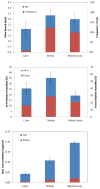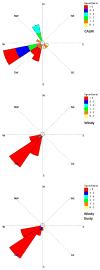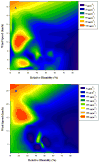Effect of wind speed and relative humidity on atmospheric dust concentrations in semi-arid climates
- PMID: 24769193
- PMCID: PMC4072227
- DOI: 10.1016/j.scitotenv.2014.03.138
Effect of wind speed and relative humidity on atmospheric dust concentrations in semi-arid climates
Abstract
Atmospheric particulate have deleterious impacts on human health. Predicting dust and aerosol emission and transport would be helpful to reduce harmful impacts but, despite numerous studies, prediction of dust events and contaminant transport in dust remains challenging. In this work, we show that relative humidity and wind speed are both determinants in atmospheric dust concentration. Observations of atmospheric dust concentrations in Green Valley, AZ, USA, and Juárez, Chihuahua, México, show that PM10 concentrations are not directly correlated with wind speed or relative humidity separately. However, selecting the data for high wind speeds (>4m/s at 10 m elevation), a definite trend is observed between dust concentration and relative humidity: dust concentration increases with relative humidity, reaching a maximum around 25% and it subsequently decreases with relative humidity. Models for dust storm forecasting may be improved by utilizing atmospheric humidity and wind speed as main drivers for dust generation and transport.
Keywords: Dust emission; PM(10); Relative humidity; Semi-arid; Wind speed.
Copyright © 2014 Elsevier B.V. All rights reserved.
Figures









References
-
- Breshears DD, Kirchner TB, et al. Modeling aeolian transport in response to succession, disturbance and future climate: Dynamic long-term risk assessment for contaminant redistribution. Aeolian Res. 2012;3:445–457.
-
- Cheng XL, Wu L, et al. Parameterizations of some important characteristics of turbulent fluctuations and gusty wind disturbances in the atmospheric boundary layer. J Geophys Res-Atmos. 2012;117:D08113. doi: 10.1029/2011JD017191. - DOI
-
- Degobbi C, Lopes F, et al. Correlation of fungi and endotoxin with PM2.5 and meteorological parameters in atmosphere of Sao Paulo. Brazil Atmos Environ. 2011;45:2277–2283.
Publication types
MeSH terms
Substances
Grants and funding
LinkOut - more resources
Full Text Sources
Other Literature Sources

